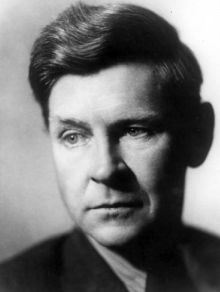Last and First Men
Book Details
| Title: | Last and First Men | ||||||||||
| Author: |
| ||||||||||
| Published: | 1930 | ||||||||||
| Publisher: | Methuen & Co. Ltd. | ||||||||||
| Tags: | fiction, philosophy, science fiction | ||||||||||
| Description: | A Story of the Near and Far Future is a “future history” science fiction novel written in 1930 by the British author Olaf Stapledon. A work of unprecedented scale in the genre, it describes the history of humanity from the present onwards across two billion years and eighteen distinct human species, of which our own is the first. The book employs a narrative conceit that, under subtle inspiration, the novelist has unknowingly been dictated a channelled text from the last human species.
Stapledon’s conception of history is based on the Hegelian Dialectic, following a repetitive cycle with many varied civilisations rising from and descending back into savagery over millions of years, but it is also one of progress, as the later civilisations rise to far greater heights than the first. The book anticipates the science of genetic engineering, and is an early example of the fictional supermind; a consciousness composed of many telepathically linked individuals.—Wikipedia. [Suggest a different description.] |
||||||||||
| Downloads: | 3,883 | ||||||||||
| Pages: | 220  |
Author Bio for Stapledon, Olaf

William Olaf Stapledon (10 May 1886—6 September 1950)—known as Olaf Stapledon—was a British philosopher and author of science fiction. In 2014, he was inducted into the Science Fiction and Fantasy Hall of Fame.
Stapledon was awarded a PhD degree in philosophy from the University of Liverpool in 1925 and used his doctoral thesis as the basis for his first published prose book, A Modern Theory of Ethics (1929). However, he soon turned to fiction in the hope of presenting his ideas to a wider public. The relative success of Last and First Men (1930) prompted him to become a full-time writer. He wrote a sequel, Last Men in London, and followed it up with many more books of both fiction and philosophy.
Stapledon’s fiction often presents the strivings of some intelligence that is beaten down by an indifferent universe and its inhabitants who, through no fault of their own, fail to comprehend its lofty yearnings. It is filled with protagonists who are tormented by the conflict between their “higher” and “lower” impulses.
Stapledon’s writings directly influenced Arthur C. Clarke, Brian Aldiss, Stanisław Lem, Bertrand Russell, John Gloag, Naomi Mitchison, C. S. Lewis, Vernor Vinge, John Maynard Smith and indirectly influenced many others, contributing many ideas to the world of science fiction. The “supermind” composed of many individual consciousnesses forms a recurring theme in his work. Star Maker contains the first known description of what are now called Dyson spheres. Freeman Dyson credits the novel with giving him the idea, even stating in an interview that “Stapledon sphere” would be a more appropriate name. Last and First Men features early descriptions of genetic engineering and terraforming. Sirius describes a dog whose intelligence is increased to the level of a human being’s.
Together with his philosophy lectureship at the University of Liverpool, which now houses the Olaf Stapledon archive, Stapledon lectured in English literature, industrial history and psychology. He wrote many non-fiction books on political and ethical subjects, in which he advocated the growth of “spiritual values”, which he defined as those values expressive of a yearning for greater awareness of the self in a larger context (“personality-in-community”). Stapledon himself named his spiritual values as intelligence, love and creative action. His philosophy was strongly influenced by Spinoza.
Source: Wikipedia
Available Formats
| FILE TYPE | LINK | ||
| UTF-8 text | 20200531.txt | ||
| HTML | 20200531.html | ||
| Epub | 20200531.epub | If you cannot open a .mobi file on your mobile device, please use .epub with an appropriate eReader. | |
| Mobi/Kindle | 20200531.mobi | ![1. Download the .mobi file into your computer’s Downloads Folder.
2. Rename the file from [8-digit number].mobi to [my title].mobi.
3. Connect your Kindle to your computer using the Kindle USB cable.
4. Open the “documents” folder in the Kindle directory and Copy/Paste
the renamed .mobi file into the “documents” folder.
5. Eject your Kindle. The file will then appear in the Kindle Main Menu
as a New item with the new renamed file name. Info](/images/info.jpg) | Not all Kindles or Kindle apps open all .mobi files. |
| PDF (tablet) | 20200531-a5.pdf | ||
| HTML Zip | 20200531-h.zip |
Kindle Direct (New, Experimental)
Send this book direct to your kindle via email. We need your Send-to-Kindle Email address, which can be found by looking in your Kindle device’s Settings page. All kindle email addresses will end in @kindle.com. Note you must add our email server’s address, [email protected], to your Amazon account’s Approved E-mail list. This list may be found on your Amazon account: Your Account→ Manage Your Content and Devices→ Preferences→ Personal Document Settings→ Approved Personal Document E-mail List→ Add a new approved e-mail address.
This book is in the public domain in Canada, and is made available to you DRM-free. You may do whatever you like with this book, but mostly we hope you will read it.
Here at FadedPage and our companion site Distributed Proofreaders Canada, we pride ourselves on producing the best ebooks you can find. Please tell us about any errors you have found in this book, or in the information on this page about this book.

